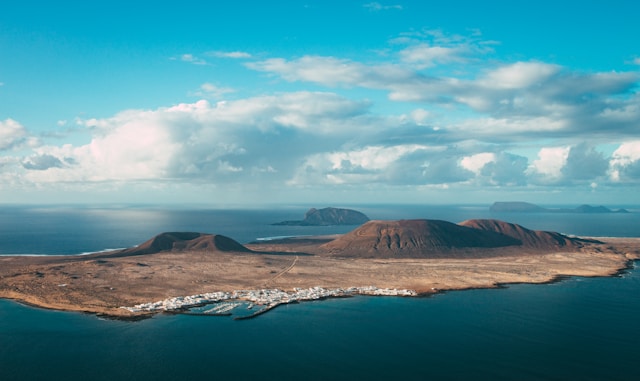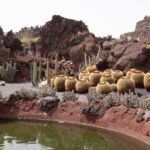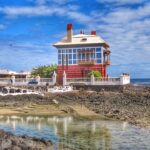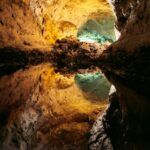Lanzarote captures the hearts of tourists and locals alike with its incredible landscapes and marvellous cultural, gastronomic, and natural spaces. Visiting the island is an unforgettable experience, making it fascinating to explore the origins of its allure by delving into the history of Lanzarote. Discover how it all began and transformed into the tourist spot it is today!
The Dawn of Lanzarote: Ancient Beginnings
The Geological Birth of Lanzarote
To understand the birth of Lanzarote and its amazing landscape, we must explore and talk about its volcanic origins.
The formation of the island takes us back 20 to 30 million years ago. During that period, the gathering of volcanic materials on the seabed, followed by a succession of eruptions, caused the island to emerge from the depths.
The First Inhabitants: Tracing Back to the Majos
The first inhabitants of Lanzarote were the Majos. They came from the north of the African continent and settled in Lanzarote around 500 BC. They lived in caves in the central area, on what is today known as Teguise.
Livestock farming, agriculture, and fishing were the economic foundations of that time, practices used until this day. As part of their culture, they worshipped the sun and the moon, among other natural elements.
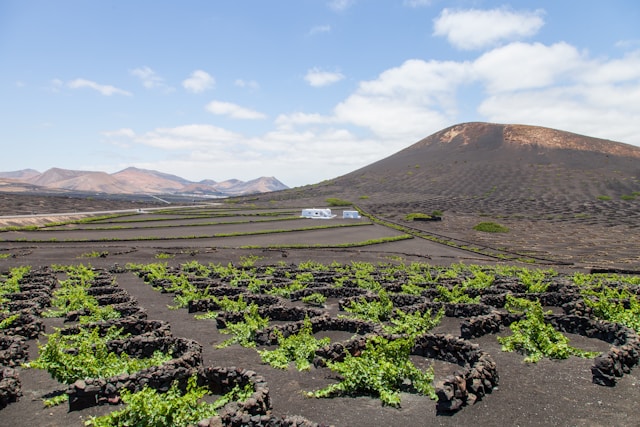
The Era of Discovery and Conquest
Lancelotto Malocello and the European Rediscovery
The arrival of the Genoese navigator Lancelotto Malocello between 1312 and 1325 to the Canary Islands marked the rediscovery of these lands, believed to have been visited by the Vikings in the 10th century.
At that time, the natives named the island Tyterogaka. However, with the arrival of this navigator, its name on maps changed to “Insula de Lançarote Mallucellus” from 1339. By the year 1402, maps were already naming it Lanzarote, as we call it today.
The Spanish Conquest: A New Chapter Begins
The conquest of Lanzarote took place in 1402. Thanks to the support received from King Henry III of Castile, the Norman knights Jean de Bethencourt and Gadifer de La Salle took control of the island. They promised the Majos to preserve their traditions and customs, but they were obligated to submit to the Crown of Castile.
However, these promises were not fully kept. The Spanish customs and traditions were imposed. So, the Majos could only maintain some ancestral traditions and their Guanche language.
The conquest also meant the adoption of the Catholic religion and the incorporation of Lanzarote into the political system of the reign.
Transformation Through Time: From the 15th Century Onwards
The influence of Volcanic Eruptions on Lanzarote’s Landscape
The area where Lanzarote is found today had volcanic activity for millions of years, and these events shaped the island’s geography, even expanding its surface.
The history of Lanzarote is related to volcanic eruptions. Due to them volcanic cones such as Montaña Roja, calderas like Caldera Blanca, and volcanic tubes like the Jameos del Agua were formed, as well as coastlines with cliffs and black sand beaches.
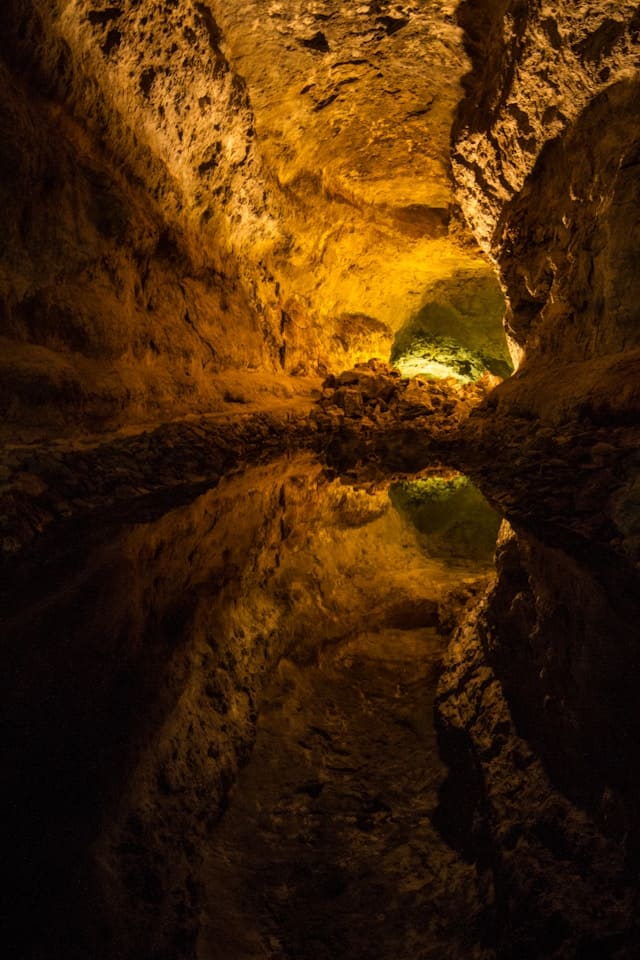
The Agricultural Revolution and Socioeconomic Changes
From the 15th century, after the conquest, the locals began to cultivate wheat, barley, and grapes. New agricultural techniques were introduced, such as crop rotation, and fertilisers started to be used.
This led to an increase in production, which was enough to feed the population, and also to trade it with other islands in the archipelago.
Cesar Manrique: Architect of Modern Lanzarote
César Manrique was an architect and artist, an icon in modern art, and a visionary who gave special importance to the preservation of Lanzarote’s culture and environment. He also encouraged quality and sustainable tourism so that the island’s unique and wonderful volcanic landscape could be preserved.
His idea was to prevent mass tourism from damaging and threatening natural spaces. Moreover, he wanted to recover the island’s characteristic architecture, incorporating local materials and traditional construction techniques in his works, and defended the importance of Lanzarote’s environment.
Key Manrique Sites: Must-Visit Locations
Among his most notable and memorable creations are:
- Los Jameos del Agua.
- The César Manrique Foundation.
- El Mirador del Río.
- The Timanfaya restaurant.
- The Cactus Garden.
Lanzarote in the Modern Era: Tourism and Preservation
The Rise of Tourism: Lanzarote on the World Stage
The tourism activity in Lanzarote dates to 1920, when the first accommodations were opened on the island. Since then, in recent decades, this sector has developed and became essential to the island’s economy, generating jobs, boosting local businesses, and improving infrastructure.
Despite the advantages, it’s also worth mentioning that the boom in tourism has brought some challenges, demanding efforts to conserve culture and natural spaces, as well as Lanzarote’s historical sites.
The creation of the César Manrique Foundation, the creation of the Timanfaya National Park, and the declaration of the island as a Biosphere Reserve in 1993 are some actions to manage this impact without affecting the economic benefits that tourism represents. Always with an intention to leverage tourism potential in the future.
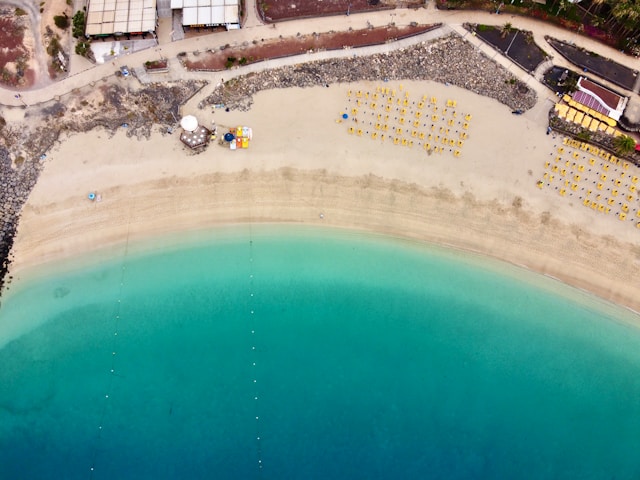
Exploring the Historical Sites of Lanzarote
Visiting Lanzarote for a weekend or more days will allow you to learn about the past and present of the island. Some historical and ancient places you must visit are:
- Timanfaya National Park. Surrounded by volcanoes, lava fields, and craters, you can appreciate a unique lunar landscape.
- Los Jameos del Agua. From this volcanic cave, you can experience something like a journey to the centre of the earth, with an internal lake, and incredible views of the Atlantic Ocean.
- Mirador del Río. A design by César Manrique, from which you can observe the Island of Graciosa and the Risco de Famara.
- Cactus Garden. One of the most visited places on the island, it houses about 4500 specimens of cacti and succulents from the five continents. Another masterpiece by César Manrique and one of the best things to do in Lanzarote.
- La Cueva de los Verdes. An underground labyrinth with superimposed and interconnected galleries, a product of the eruption of the Volcano Corona.
Book Lanzarote Airport Transfers with us, and start your journey on the island in the best way.
Conclusion
Immersing yourself in this journey through the history of Lanzarote, and understanding how it has evolved from ancient kingdoms to becoming this modern marvel, is worthwhile. But for Lanzarote to continue maintaining its essence and keep having remarkable places to show to future generations, it’s essential to reflect on the importance of preserving history and finding ways to achieve economic development.
All of this must go hand in hand with environmental sustainability. This remains a challenge today, which Lanzaroteans, governments, and tourists must face.
Our company seeks to deliver the best service you can find on the island today. We seek to optimise our clients’ time and resources, which is why we respect the schedules and offer the best prices for different transfers.

